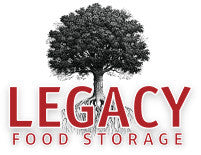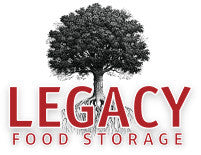Water: Your Most Important Preparedness Item
Water is hands-down the single most important thing for you to have stored in an emergency. You can survive without food for up to a month or more, depending on the circumstances, but you can only go without water for three to seven days. Water is essential for our bodies because it is involved in every bodily function: metabolism, temperature moderation, digestion, transporting nutrients, organ cushioning, and detoxification, to name a few.
In addition to supplying our bodies with crucial hydration, water is also essential for a surprising amount of day-to-day tasks. Go through a typical day for a moment to discover how much you rely on water for nearly everything you do. In a typical day, I take a shower, brush my teeth, do a load or two of laundry, cook meals with water, wash the dishes, wipe off the counters, water the garden, and give water to pets. Water is truly a part of the whole day.
Because we have water running through our faucets at any time we need it, it’s easy to start to feel like water is an endless resource. However, in an emergency, water can be shut off for days or longer. If you haven’t got water stored, it will be a very difficult and dangerous situation for you and your family.
FEMA recommends storing one gallon of water per person per day for at least three days. To me, this is a conservative amount, but I tend to be more-than-usually thirsty and typically drink nearly a gallon of water a day. I would want another gallon or so for cooking and grooming, if I could. You might also consider that you will need more water if the disaster occurs during a hot part of the year, probably close to double what you would normally need. You might also need more water for emergency medical conditions, like caring for wounds. Think about your habits and your family’s needs and store accordingly.
When you store your water, here are some recommendations to keep in mind. Using plastic containers with tight lids is probably the easiest way to go. Many people choose to buy bottled water because it is already ready for storage, but you can also bottle your own. Just make sure you are using food-grade plastic and not plastic used for other things as bad substances can leak into your water. Also, be aware that plastic bottles that formerly had anything sweet or sugary in them (including milk and fruit juice) are not good to store water in because the sugar in these products is almost impossible to remove from the plastic. When you then store water in them, that sugar will be an instigator of bacteria growth. Also, don’t use metal containers as they can corrode and leak dangerous substances into the water. You can use food-grade glass or stainless steel containers as well, as long as you have sterilized them.
If you choose to bottle your own water, first be sure to sanitize your containers well. This could mean washing them with hot water and dish soap and then rinsing them out with a solution of 1 tsp. of bleach to 1 quart of water. Then be sure to rinse everything out thoroughly with water and let them dry well. When you fill them with water, try not to touch the inside of the lid or the lip of the bottle with your fingers.
Rotate your water every six months if you have bottled it yourself or every year if you have already bottled it to ensure that it stays fresh. Store it out of light and away from heat.
If your emergency situation lasts and turns into a survival situation, you may find that no matter how much water you had stored, it wasn’t enough. In this case, you will need to know how to purify water and/or be supplied with appropriate water purification gear.
How to Make Most Water Safe in an Emergency
One option for purifying your water is to purchase a water filtration device and store it with your emergency supplies. BuyEmergencyFoods offers a variety of different water purification systems, from water bottles to family-size pitchers to filtering straws–to offer you the ultimate in convenience. (There aren’t many options more convenient than having your water purified for you as it travels through your straw.)
If you don’t have a water purifier around, you can follow FEMA’s recommendation and use chlorine bleach. It takes 16 drops of regular household liquid bleach to purify one gallon of water.
You can also boil water vigorously for 1-2 minutes. Some experts even claim that you don’t have to get water to a boil; you simply have to bring it to pasteurization temperature, which is only 150 degrees. Because you may not have a thermometer around, bringing it to a boil will probably be your safest bet. If you’re wondering how you would boil something in a survival situation, you’ve got several options. If you’ve planned ahead and have got some kind of camp stove and fuel stored, you are set. Another option is to use a solar oven, either one you have purchased or one you have made (They are very simple to construct and use materials you most likely have around.)
Another option for purifying fresh water is to use water purification tablets. Water purification tablets typically release iodine into the water, which kills most pathogens in fresh water. They often come with a partner Vitamin C tablet, which you put in the water after the iodine one has done its job. The Vitamin C tablet takes away the taste of the iodine and makes the water ready for drinking. Purification tablets can be purchased online or in outdoor gear stores and are pretty inexpensive.
When a natural disaster strikes, cracked water lines can allow polluting substances into the water that feeds into your house. Alternatively, the water can be shut off altogether. In many cases, you will have to rely on the water you have stored to keep your family from dehydration and to perform daily household and hygiene activities. Because water is so essential for survival, storing water is the most important thing you can do to be prepared for an emergency. Start now and make sure you have enough water stored for your family. Also be sure you have stored it safely, and become educated on ways to purify fresh water should this become necessary. You will never regret having water on hand when things go bad.
The post Water: Your Most Important Preparedness Item appeared first on Buy Emergency Food.
Tags
- All
- 25 year food
- 25 year shelf life food
- 72 hour kit
- Best food storage types
- Best long-term food storage
- Blizzard preparedness
- Budgeting
- canning
- Certified GMO-free Emergency foods
- Certified GMO-free foods
- Coffee
- Comparison of emergency food methods
- Composting tips
- Dangers of genetically modified foods
- dehydrated food
- Edible Wild Plants
- emergcy preparedness
- Emergency Cooking
- Emergency Food
- Emergency food Christmas gifts
- emergency food storage
- Emergency Food Supply
- Emergency food supply recommendations
- Emergency Planning
- Emergency Preparedness
- Emergency preparedness advice
- emergency preparednesss
- Emergency Supplies
- Emergency supplies checklist
- Emergency Survival
- emergency survival gear
- Emergency survival kit checklist
- Emergency Survival skills
- exercise
- Family emergency preparedness
- Family emergency preparedness plan
- Family Preparedness
- Food Storage
- Food storage 25 year shelf life
- Food storage amounts
- Food storage Christmas
- Food storage containers long term
- Food Storage Secrets
- Food storage serving size
- Food storage types compared
- freeze dried food
- Freeze dried food storage
- freeze dried meats
- Freeze-dried emergency food storage
- Fruit Trees
- Gardening
- Getting Started
- Gluten-free food Storage
- Gourmet emergency food
- Healthy food storage
- How much emergency food to store
- Improved emergency preparedness
- Jared Markin
- Jared Matkin
- Legacy Premium
- Lessons learned from Hurricane Sandy
- Lessons learned from natural disasters
- long-term food storage
- Long-term Food Storage Guidelines
- Long-term Food Storage tips
- Long-term water storage
- Mental Emergency Preparedness
- Mental toughness
- Money-saving tips
- Natural disaster planning
- Natural Disasters
- Perfect Christmas gifts
- Pet Emergency preparedness checklist
- Pet Emergency preparedness kit
- Pet Emergency Survival tips
- Pets and Emergency Preparedness
- Plant Foraging
- portable solar panels
- portable solar power
- portable water filters
- protein drinks
- Risk of genetic modification
- Seed saving and storage
- Seed saving guide
- Self-reliance
- Self-reliant practices
- Shelf Life
- Solar Cooking
- Solar Ovens
- Special Dietary needs
- Stranded in a car in a blizzard
- Survival food
- Survival Gear
- survival kit
- Survival kits
- Survival Ovens
- Survival Skills
- survivalist gear
- suvival kit
- Tree Pruning tips
- Tree Trimming basics
- unique ideas
- water bottle with filter
- water filter
- water filter straw
- water filters
- Water Filtration
- water pitcher with filter
- water pitchers with filters
- Water purification
- Wild Food Foraging
- Winter composting
- Winter driving
- Winter preparedness tips
- Winter storm preparedness tips
- Winter Survival







